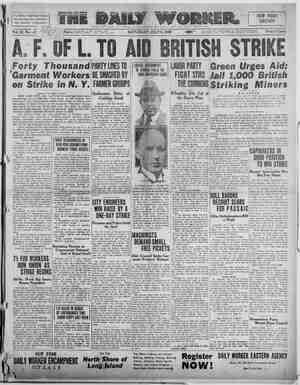The Daily Worker Newspaper, July 3, 1926, Page 9
You have reached the hourly page view limit. Unlock higher limit to our entire archive!
Subscribers enjoy higher page view limit, downloads, and exclusive features.
Labor in Early American History Leaders of the 1880’s—Organizations—Struggles JOHN McBRIDE President Ohio Coal Miners’ Union. ROBABLY the first labor organ ever printed in the United States was the Workingman’s Advocate, which began publication in 1825 by the Evans brothers. This publication, after a few years, gave place to the Daily Sentinel, and this, in turn, to the Young America, which last printed at its head the first American labor platform, consisting of twelve de- mands, as follows: First. The right of man to the soil. Vote yourself a farm. ' “Second. Down with monopolies, es- pecial the United States Bank. Third. Freedom of public lands. Fourth. Homesteads made inalien- able. Fifth. Abolition of all laws for the collection of debts. Sixth. A general bankrupt law. Seventh. A lien of the laborer upon his own work for his wages. Eighth. Abolition of imprisonment for debt. Ninth. Equal rights for women with men in all respects. Tenth. Abolition of chattel slavery, and of wage slavery. Eleventh, Land limitation to one hundred and sixty acres; no person after the passage of this law to be- come possessed of more than that amount of land. But when a land monopolist died his heirs were to take each his legal number of acres, and be compelled to sell the overplus, using the proceeds as they pleased. Twelfth. Mails in the United States -~to run on the Sabbath. P. F. McGUIRE Secretary Brotherhood of Carpenters and Joiners, GEORGE HARRIS President Amalgamated Association of Miners and Mine Laborers. gprs first American trade union of which there is authentic record was the New York Society of Journey- men Shipwrights, incorporated on the 3rd of April, 1803. T. V. POWDERLY Grand Master Workman Knight of Labor. WM. WEIHE President Amalgamated Iron and Steel Workers. PETER M. ARTHUR Grand Chief Brotherhood Locomotive Engineers, HE “sailors’ strike” in New York City, in 1802, was probably the first in America, The sailors demand- ed of the ship owners an increase to P $14 a month instead of $10. They quit work and paraded in streets 5 with a band, inducing their shipmates : to join the procession. The constables turned out, arrested the leader, locked him in jail, and put a summary end to the strike under the conspiracy stat- ute. Thirty-five years later this conspir- acy statute was bitterly aSsafled ina . labor pamphlet which said “The laws have made it a just a meritorious act that capitalists shall combine to strip F the man of labor of his earnings, whereas if mechanics (workers) com- bine to raise wages the laws punish them as conspirators against the good of society, and the dungeon awaits them as it does the robber.” The first victory of the workers against this law was won in the fa- mous “Journeyman Bootmakers’ case” in Massachusetts in 1842. The prose- cution brought against the bootmak- ers’ union, under the old conspiracy laws, was then decided in favor of the defendants. * . * HE first labor representative to the United States congress was elect- ed during Jackson’s second adminis- tration. His name* was Ely Moore, president of the General Trades Unions of the City of New York, in 1833. i WM. AMISON President International Typographical Union. Re a eS Tae




